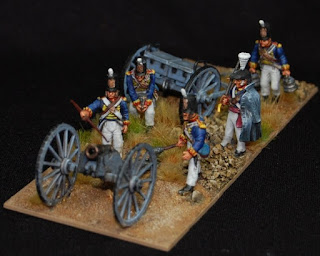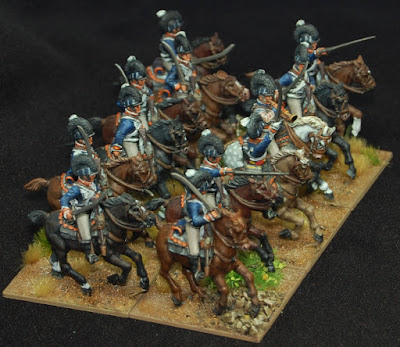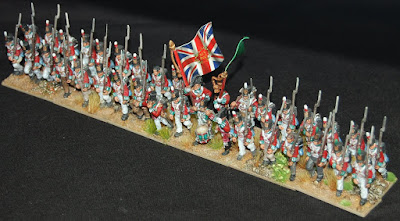Jednostka dziś omawiana zdobyła bogatą tradycję bojową jeszcze przed wojnami napoleońskimi. Bowiem już 23 marca 1689 r. Lord Herbert z Chirbury powołał 23 pułk pieszy. Pułk posiadał silną więź z Walią, z tych ziem rekrutowano większość kadr.
Jednostka w czasach napoleońskich zachowała archaiczną pisownię swej nazwy: Welch zamiast Welsh i Fuzileers zamiast Fusiliers, ale tylko niefomalnie - w formie inskrypcji na broni białej oficerów.
The unit discussed today has gained a rich fighting tradition even before the Napoleonic wars. For on March 23, 1689, Lord Herbert of Chirbury set up the 23rd Regiment of Foot. The regiment had a strong bond with Wales, most of the personnel were recruited from these lands.
The unit in Napoleonic times retained the archaic spelling of its name: Welch instead of Welsh and Fuzileers instead of Fusiliers, but only informally - in the form of an inscription on officers' swords.
W 1801 roku pułk walczył pod Aleksandrią w Egipcie.
2
batalion pułku jesienią 1808 roku dołączył do armii
Sir Johna Moore'a na półwyspie iberyjskim. Zimą 1808-09 przetrwał wyczerpujący marsz w strasznych warunkach przez góry północnej Hiszpanii w odwrocie do La Coruny. Strzelcy walijscy jako ostatni opuścili hiszpańską ziemię. Kapitan Thomas Lloyd Fletcher i kapral zamknęli dolną
bramę La Coruny, używając bagnetu, aby przekręcić klucze w
dość sztywnym zamku, dając batalionowi wystarczająco dużo czasu na
wejście na pokład statku, by uciec droga morską. Fletcher schował klucze do kieszeni i dziś są one jednym
ze skarbów w muzeum pułku w Caernarfon.
In 1801 the Regiment fought at Alexandria in Egypt.
The 2nd battalion of the Regiment in the autumn of 1808 joined the army of Sir John Moore on the Iberian Peninsula. In the winter of 1808-09, an exhausting march in terrible conditions survived through the mountains of northern Spain on the reverse of Corunna. Welsh Fusiliers were the last to leave Spanish soil. Captain Thomas Lloyd Fletcher and the corporal closed the lower gate of Corunna, using a bayonet to turn the keys in a fairly stiff castle, giving the battalion enough time to board the ship to escape by sea. Fletcher has hidden keys in his pocket and today they are one of the treasures in the Caernarfon regiment museum.
 |
| Klucze od dolnej tylnej bramy La Coruny. |
|
1 batalion pułku na półwysep iberyjski został wysłany w grudniu 1810 roku, bił się krwawo pod Albuerą, szturmował Badajoz i Ciudad Rodrigo, uczestniczył w starciach pod Salamanką i Vitorią, następnie prowadził walki
we Francji. Pod Waterloo stracił dowódcę.
1 battalion of the Regiment was sent to the Iberian Peninsula in December 1810, fought bloody at Albuera, stormed Badajoz and Ciudad Rodrigo, participated in clashes with Salamanca and Vitoria, then fought in France. He lost his commander at Waterloo.
Stworzyłem w 28mm batalion 23 pułku strzelców walijskich z zestawu Perrych: BH1 Plastic Napoleonic British Line Infantry box set (36 Line Infantry, 4 Riflemen). Był to w kolei trzeci mój oddział. Dodałem parę rączek z Victrixa; pasują.
I created in the 28mm battalion of the 23rd Royal Welsh Fusiliers Regiment of Foot from the Perry set: BH1 Plastic British Napoleonic Line Infantry box set. It was, in turn, my third unit. I added a some of Victrix hands; They fit.
Zestaw Perrych jest świetny, pozy stylowe, miny żołnierzy dziarskie, ciekawe
elementy mundurowe np. nieregularnie ułożone pompony. Jedyną wadą jest
to, że nie można z niego zrobić oddziału w marszu.
The Perry set is great, stylish poses, perky soldiers' faces, interesting uniform elements, e.g. irregularly arranged pompoms. The only drawback is that you can't make a squad of it on a march.
Typowo
w piechocie brytyjskiej przełomu wieków XVII i XIX batalion składał się
z 10 kompanii. 8 z nich było kompaniami centralnymi, 2 flankierskimi (1 grenadierska i 1 lekka). Kompanie grenadierską i lekką odwzorowują po 3
modele z każdego skrajnego skrzydła formacji, na przedzie. Widoczny jest
inny kolor pomponów kompanii: grenadierska posiada białe, lekka -
zielone.
Typically, in the British infantry of the turn of the seventeenth and nineteenth centuries, the battalion consisted of 10 companies. 8 of them were central companies and 2 were flank companies (1 grenadier and 1 light). The grenadier and light companies copy 3 models from each extreme wing of the formation, in the front. A different color of pompoms of the company is visible: the grenadier one has white, the light one - green.
Żołnierzy
pułku wyróżniała charakterystyczna naszywka: składająca się z pięciu
nakładających się czarnych jedwabnych wstążek (siedem cali dla żołnierzy
i dziewięć cali dla oficerów) z tyłu munduru na wysokości szyi. To
spuścizna czasów, kiedy żołnierze nosili harcapy. W 1808 r. praktyka ta
została zakazana, ale Walijczycy służyli w Nowej Szkocji, kiedy wydano
rozkaz zaprzestania ich noszenia. Następnie wypłynęli na morze i
ostatecznie nie otrzymali rozkazu. Po powrocie podczas inspekcji zostali
skarceni za niewłaściwe fryzury. Postanowili zachować wstążki, z
którymi wiązany był harcap, jako oświadczenie przeciwko przeregulowaniu,
i otrzymali tę specjalną ulgę od króla.
Ciekawą
anegdotką jest, że Rada Armii próbowała usunąć naszywkę podczas
pierwszej wojny światowej, powołując się na powody, dla których Niemcy mogliby ustalić, która jednostka stoi przed nimi. Pułk odparł,
pytając: "przy jakiej okazji od czasu odwrotu z La Coruny, kiedy pułk
był ostatnim, który opuścił Hiszpanię, z kluczami od bramy w kieszeni jednego z
oficerów, wrogowie Jego Królewskiej Mości widzieli plecy strzelców
walijskich?". Sprawa pozostała zawieszona przez całą wojnę.
The Regiment's soldiers were distinguished by a characteristic flash: consisting of five overlapping black silk ribbons (seven inches for soldiers and nine inches for officers) on the back of the uniform at the height of the neck. This is the legacy of the times when soldiers wore pigtails. In 1808 this practice was banned, but the Welsh served in Nova Scotia when they were ordered to stop wearing them. Then they went to sea and eventually did not receive an order. After returning during the inspection they were reprimanded for improper hairstyles. They decided to keep the ribbons with which the pigtail was tied as a statement against overregulation, and received this special relief from the king.
An interesting anecdote is that the Army Council tried to remove the flash during the First World War, citing the reasons why Germany could determine which unit is facing them. The regiment replied, asking: "on what occasion since the retreat from Corunna, when the regiment was the last to leave Spain, with the keys from the gate in the pocket of one of the officers, enemies of His Majesty saw the back of Welsh shooters?". The case remained suspended throughout the war.
Oto naszywka:
Here is the flash:
Pokusiłem się o wykonanie takich naszywek na modelach, na których mogłyby być widoczne - tj. na nie posiadających plecaków: oficerze i chorążych.
I was tempted to make flashes on models where they could be seen - i.e. on those without backpacks: officer and ensign.
Zestaw pozwala na wykonanie interesującej pozy dwóch żołnierzy - przekazujących sobie prawdopodobnie ładunek - ukazuję to poniżej, żeby nie umknęła komuś ta możliwość złożenia.
The set allows you to make an interesting pose of two soldiers - probably giving each other bullets - I show it below so that someone does not miss this possibility of folding.
I parę zbiorowych fotek na koniec:
And a few collective photos at the end:

























































